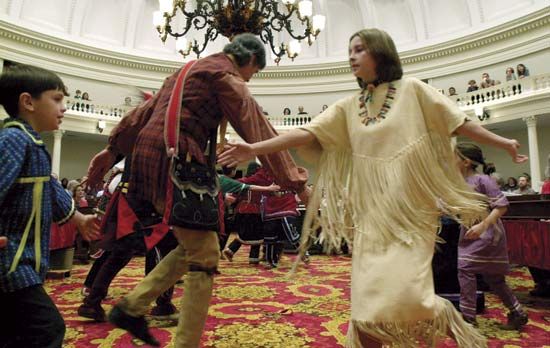Abenaki
Our editors will review what you’ve submitted and determine whether to revise the article.
News •
Abenaki, Algonquian-speaking North American Indigenous people that united with other peoples in the 17th century to furnish mutual protection against the Haudenosaunee (Iroquois) Confederacy. The name refers to their location “toward the dawn.” In its earliest known form, the Abenaki Confederacy consisted of tribes or bands living east and northeast of present-day New York state, including the Abenaki, Passamaquoddy and Penobscot in present-day Maine, Malecite and Mi’kmaq (Micmac) in present-day Maritime Provinces, and Cowasuck, Sokoki, and others in present-day Vermont and New Hampshire. Later the confederacy included some groups as far south as present-day Delaware.
Traditional culture
Traditional Abenaki social organization consisted of relatively small kin-based bands led by a civil chief who advised the group and facilitated consensus-based decision making; there was usually a separate war chief. A general council of all adult men and women decided matters relating to war; a smaller council of chiefs and representatives from each family decided other questions of importance to the group. In order to cement relations between bands and with other tribes, the Abenaki engaged in a form of institutionalized comradeship that united two men for life in ritual brotherhood.
The Abenaki engaged in a diversified economy that included hunting, fishing, horticulture, and gathering wild plant foods; the proportion of each activity varied depending on a given band’s proximity to the Atlantic coast. Game was taken in snares and traps and by bow and arrow and could include marine mammals such as seals and dolphins; fishing was undertaken in fresh and salt water. Corn (maize), beans, and squash were grown throughout the tribe’s home territory, albeit more intensively in its milder southern reaches. Berries, nuts, mushrooms, maple syrup, and a variety of medicinal plants were among the wild plant foods exploited by the tribe. The typical Abenaki dwelling was the birch-bark-covered wickiup occupied by several families. The birch-bark canoe was in general use for transportation.
After European contact
The Abenaki interacted with a variety of Europeans during the 16th century; at that time, French, Basque, and English fishermen routinely traversed the North Atlantic to access the great schools of fish found on the Grand Banks. Contact with Europeans exposed Native Americans to Old World diseases for which they had no immunity, eventually depleting Abenaki populations.
As the French and English colonial systems developed in the 17th century, the Abenaki became involved in the fur trade, exchanging beaver and other pelts for imported goods such as metal tools and glass beads. The Abenaki were heavily missionized by French Jesuits in the late 1600s. As a result of this influence, the Abenaki allied with the French against the English in the colonizers’ competition for Indigenous trade and territory. Severe defeats in 1724 and 1725 again reduced the tribe’s numbers; most withdrew to Canada, eventually settling at Saint-François-du-Lac in Quebec.
There are two Abenaki reserves in Canada, both located in the province of Quebec. In 2024 the Abernaki of Wôlinak had a registered population of 709, including 125 people who lived on the reserve, and Odanak had a registered population 3,102, including 279 people who lived on the reserve. In 2011 and 2012 the state of Vermont extended tribal recognition to four groups who asserted Abenaki descent: the Elnu Abenaki Tribe, the Nulhegan Abenaki Tribe, the Abenaki Nation at Missisquoi, and the Koasek Traditional Band of the Koas Abenaki Nation. Of these, only the Abenaki Nation at Missisquoi has sought to become a federally recognized tribe in the United States. The petition for recognition was denied in 2007 by the Department of the Interior, which claimed the group did not sufficiently demonstrate lineal descent from, or social or historical connection with, the Abenaki to be considered a tribe under federal law.













